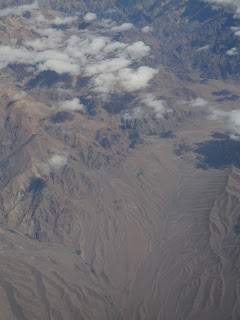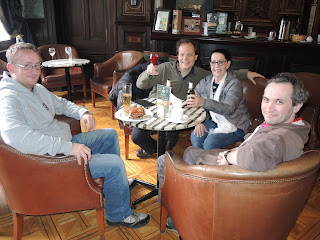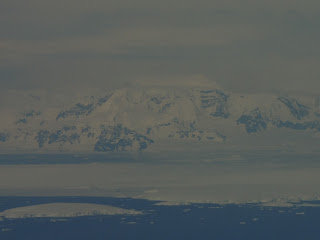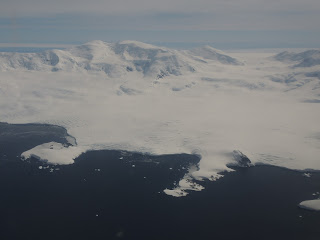A relaxing day in Punta Arenas, Patagonia - Chile's southernmost city, literally at the southern tip of the American continent... this was not planned as I was meant to fly from here to Rothera Research Station in Antarctica this morning. But there was a backlog of a group of scientists who were meant to fly on the same route and plane, a Canadian-built 4-engine Dash 7, days ago, and who were grounded here due to weather conditions preventing any flights to Rothera, who had priority on today's flight.
It was a long trip from northern Scotland to Punta Arenas! I left home in Newburgh, Aberdeenshire, on a sunny winter morning, and I flew from Aberdeeen to London Heathrow. From there, an 11-hour overnight flight took me and a small team from the British Antarctic Survey to Sao Paulo - Guarulhos. After few hours on the ground in Brazil, we reached Santiago de Chile after another 4 1/2 hour flight. I always ask for window seats, and it was again worthwhile this time: I got very scenic views of southern Brazil, southern Paraguay and northern Argentina - especially of the Paraná River, the desert region of northern Argentina around Mendoza, and then the Andes. At that point, the aircraft had started its descent into Santiago SCL, which meant that some of the Andean summits around us were higher than the plane...
We landed in Santiago in early summer, in a sweltering 27°C in the overcrowded Arturo Merino Benítez Airport (SCL). After a lunch of pizza and fries, we were in the air again for 3 h, this time on the way to Punta Arenas (PUQ).
(Click on the images for a full-screen, high-resolution view.
You can browse by using the cursor buttons.)
You can browse by using the cursor buttons.)
View from my home over the Ythan Estuary in Aberdeenshire
on my departure morning for the big trip
on my departure morning for the big trip
Flying SW across the Atlantic between Madeira and the Azores to Brazil...
...after an 11 h overnight flight, we reached Sao Paulo
Final approach to Sao Paulo-Guarulhos in the early hours of Dec. 21
The B777-300 that carried the BAS team from Heathrow to Sao Paulo
Final views of Sao Paulo, en route to Santiago de Chile
Rio Grande do Sul, Brazil
Southern Paraguay, bordering Rio Grande do Sul (Brazil) and Argentina
The Paraná River, northern Argentina
Desert south of San Juan, northern Argentina
And suddenly, the Andes rise out of the flat desert (in the left of the image!)
The leeward (Argentine) side of the Andes is a dry desert at this latitude...
...only the highest summits had a bit of snow, the rest looks very dry
The eastern part of the Andes (west of Mendoza, Argentina)
At this point, the plane had started its descent into Santiago de Chile SCL
- some of the summits were higher than we were!
- some of the summits were higher than we were!
Plantations and a large photovoltaic solar power station NE of Santiago de Chile,
in the foothills of the Andes
in the foothills of the Andes
Hercules of the Peruvian Air Force on a visit to Chile
Leaving Santiago de Chile SCL for Punta Arenas PUQ
Leaving Santiago de Chile SCL for Punta Arenas PUQ
The flight from Santiago to Punta Arenas is one of the most scenic flights that I have ever taken - provided that one has a window seat on the left hand side on the southbound flight and a cloudless skies. I had flown that route 11 years earlier, on January 6, 2007, during my first expedition to this part of the world, when I was lucky on both counts and got amazing views and photos of the Andean peaks and glaciers caving into the Pacific fjords of southern Chile. Yesterday and with these images passing by again, memories from that day made me quite sad, considering that two of the participants of the 2007 expedition, Helga Mueller and my mother, had passed away in recent years.
Volcano in south-central Chile
Volcano in south-central Chile
Patagonian glacier in the border region between southern Chile and Argentina
Final approach to Punta Arenas PUQ, coming from Santiago SCL
The BAS Dash-7 which will carry us to Antarctica as soon as weather will be permitting
In Punta Arenas, we were greeted by an icy wind and 10°C.
The only further activity today was the mandatory pre-flight safety
briefing before the flight on the BAS Dash-7, a sturdy 4-engine,
Canadian-built aircraft which has been maintaining the air link between
Rothera Research Station and either Punta Arenas or the outside world
for many years. Very tired from 2 solid days of flying and traveling, we
fell into our beds for some much-needed sleep.
This
morning we learned that even though the Dash-7 would fly to Rothera
today, we wouldn't be on it. The reason was a backlog of scientific
passengers who were meant to fly to Rothera during the previous days,
but who couldn't fly due to weather conditions. Given that the aircraft
has only 8 passenger seats and a large cargo bay, those who had been
waiting here were given priority on today's flight, and the plane would
likely return tonight and hopefully fly us to Rothera tomorrow.
Memorial to the arrival of Magellan's expedition in the area, on the waterfront of Punta Arenas
Memorial to the arrival of Magellan's expedition in the area, on the waterfront of Punta Arenas
King cormorants on a defunct pier in Punta Arenas
King cormorants on a defunct pier in Punta Arenas
The RRS James Clark Ross (nicknamed "JCR")
and the ARSV Laurence M. Gould moored in Punta Arenas
and the ARSV Laurence M. Gould moored in Punta Arenas
The waterfront of Punta Arenas
Street scene in Punta Arenas
Penguins are everywhere in Punta Arenas... the local newspaper.
Monument of Magellan in the central square of Punta Arenas. The native's toe (see the shiny brass of the statue at the base) apparently has a spell which keeps every traveler who touches it in Punta Arenas... I did this during a previous trip from here to the Falklands in early 2007 - and the flight was doomed: The aircraft was
within 5 m of the ground in the Falklands but couldn't land due to high
cross winds... it made an emergency re-ascent and had to divert to
Argentina for refueling since it wouldn't have enough kerosene to fly
back to Chile... where we were grounded until the wind conditions in the
Falklands eased. ...so I have avoided touching or kissing it this time...
Central square in Punta Arenas
Chile is a seismically very active country, and its coastal areas are a tsunami hazard area
View over Punta Arenas from Cerro de la Cruz
Squid fishing vessels moored in the Straits of Magellan off Punta Arenas
The historic building with Shackleton's Bar in the center of Punta Arenas
A very memorable reunion in Shackleton's Bar:
Derek (RAF), Frithjof, Cherry and Matt (Univ. Cambridge)
(left to right)
Derek (RAF), Frithjof, Cherry and Matt (Univ. Cambridge)
(left to right)
Shackleton's Bar
Saturday, Dec. 23, 2017
No luck - weather conditions at Rothera were still reported to be unforgiving for any attempt to fly there. Another day grounded in Punta. This is what it means traveling to Antarctica!
Matt, Derek and I had a little walk around town - I then had lunch again at Shackleton's Bar, before spending the rest of the day in my hotel room working on a funding proposal.
And in the evening - back to Shackleton's Bar, for dinner and some Chardonnay...
Sunday, Dec. 24
The morning briefing by the Dash-7 pilots did not bring the desired news - weather along the flight path to Antarctica was still too poor today. One more day in Punta - Christmas Eve. Back to proposal writing, and the daily walk to Shackleton's Bar for lunch.
Then, in the afternoon, the much-awaited news: Weather on the way to "our" part of Antarctica was finally improvement, and we should be ready for flying tomorrow morning! Hooray.
Matt and I were planning for an early Xmas dinner tonight - but we would keep it light, we have to be fit tomorrow morning!
Feliz Navidad de Chile!
The impressive Peruvian polar research vessel off Punta Arenas
The Hotel Diego de Almagro
where have now spent 3 days longer than planned on our way to Antarctica
where have now spent 3 days longer than planned on our way to Antarctica
In the end, we had a lovely, light Christmas dinner. For Marlin, the diver sitting next to me, this would be the last dinner in civilization until March 2019! And, amazingly, the two pilots of the Dash-7 still remembered me from my Antarctic trip in 2010-2011. Not only that, they even remembered the contents of the seminar that I had given at Rothera then! Where else in the world would you get that...
Xmas dinner in Punta Arenas
Monday, 25 December 2017
Finally we are in the air! During the pilots’ briefing at 8
am this morning, the forecast of very good weather along the western side of
the Antarctic Peninsula was confirmed. We had half hour for finishing breakfast
– since we had been pre-alerted the night before that the flight might finally
happen this morning, luggage was already mostly ready.
A handling agent who came to the hotel collected our
passports and cleared emigration formalities for us. A minivan drove us to the airport.
After passing security and a short wait, we boarded the Dash-7. A total of 7
passengers, 2 pilots and 1 flight engineer. This aircraft was built in 1988,
but it is still going very strong due to an overall low number of flying hours
and, as one of the pilots told me during my visit to the flight deck, it can
probably still fly for another 50 years. The trouble is getting spare parts for
such an old and increasingly rare model. BAS has opted to stay with the de
Havilland Canada Dash-7 due to its sturdiness, but also in particular its STOL
(short take-off / landing) capability, making it suitable for the short gravel
runway at Rothera which not many other models can handle.
Loading the Dash-7 at PUQ
Loading the Dash-7 at PUQ
Islands west of Tierra del Fuego
Visit to the flight deck
The Dash-7 is a sturdy, 4-engine turboprop aircraft with STOL capability, ideal for short, unpaved runways in polar regions
With Al on the flight deck
Our flight path from PUQ to Rothera
One of the first icebergs that came into sight
Snow-covered mountains, sea ice...
Snow-covered mountains, sea ice...
Snow-covered mountains, sea ice...
A mailbag (full of Xmas mail for the folks at Rothera) that was meant to have reached Rothera on the RRS James Clark Ross ("JCR")... which got stuck in sea ice and had to return to the Falklands. It will now reach Rothera on the Dash-7
The sea ice that prevented the JCR from reaching Rothera
The sea ice that prevented the JCR from reaching Rothera
A very smooth, almost 5 hr flight, and I was able to visit
the pilots in the flight deck for about an hour and chat with them. I love
flying, anywhere in the world, and I have always been fascinated by aircraft.
Lots of thoughts and emotions are going through my mind on this flight. What
has happened in the world and in my life since I last was in Antarctica in
early 2011, from where I left with the same pilots, on the same aircraft… while
I was in Antarctica last time, the Arab Spring started and the wars in Syria
and Yemen broke out. I have become a professor at Aberdeen, my mother had
passed away, I bought a home… the presently unfolding disaster of BREXIT had
been unimaginable back then… as was a President Donald Trump! But also, the
world community has become more sincere than ever before in reigning in
man-made climate change, some of the effects of which I am about to study in
Antarctica – the Paris Agreement has been signed, and even Trump won’t be able
to revert that any more.
I got a lovely Christmas present from my American friend Bob
Andersen (previously Director of the Culture Center for Marine Phytoplankton,
Bigelow Laboratory, Maine, USA) - he has given a new, Chrysophyte-like alga
from Tierra del Fuego my name:
(Han et al.,
PROTIST, in press:)
278 Sungminbooa
kuepperi sp. nov. R.A.Andersen & B.Melkonian (Fig.
12)
279 Diagnosis:
vegetative
cells 4-6 μm wide
and 5-9 μm long;
cells organized in packets with 4 to 16 cells
280 within thick mucilage; typically one plate-like
parietal chloroplast with a pyrenoid; peripheral granules
281 and chrysolaminarin vacuole present; DNA
sequences representing the 18S rRNA (HQ710577), psaA
282 (HQ710671),
psaB (KM010177), psbA (MF927443), psbC (HQ710772) and rbcL
(HQ710621) genes
283 distinctive
and unique.
284 Holotype
here designated: cells from culture A11,864 were preserved and
mounted on a microscope
285 slide
and deposited in the New York Botanical Garden herbarium (NY), New York City,
NY USA as
286 No.
02335010.
287 Type
locality: Isla Redonda, Beagle Channel, west of Ushuaia, Tierra del Fuego,
Argentina (Jan 2007).
288 Etymology:
the
organism is named in honor of Prof. Frithjof Küpper who has contributed
significantly
289 to phycology and who collected this alga.
993 Figure 12. Sungminbooa
kuepperi sp. nov. A11,864. A. Cluster of
cells showing the cell arrangement in
994 bundles of 4-8 cells. Note the gel sheaths
(arrowheads). B. Enlarged view of cells showing the
995 parietal
chloroplast. Note the protruding pyrenoid (arrow). Scale bars = 10 μm.
I had isolated this alga while working
at SAMS in Oban in summer 2007, from a substratum sample which I had collected
during a dive in the Beagle Channel near Ushuaia, Tierra del Fuego. And what a
memorable dive that had been! That was my first dive ever with a dry suit, and
I got pretty wet on that occasion… and the local dive guide, Carlos Giuggia,
had been pilot flying French-built fighter jets in the Falklands War, but had
opted to become a diver as a safer career option afterwards.
The sea ice that prevented the JCR from reaching Rothera
The sea ice that prevented the JCR from reaching Rothera
The sea ice that prevented the JCR from reaching Rothera
The sea ice that prevented the JCR from reaching Rothera
A glaciated ridge on Adelaide Island, and a bay still covered with sea ice in the foreground
A glaciated ridge on Adelaide Island, and a bay still covered with sea ice in the foreground
A ridge with a heavily crevassed glacier beneath it
Mountains and glaciers on Adelaide Island north of Rothera
Mountains and glaciers on Adelaide Island north of Rothera
Mountains and glaciers on Adelaide Island north of Rothera
Mountains and glaciers on Adelaide Island north of Rothera
Mountains and glaciers on Adelaide Island north of Rothera
Heavily crevassed glacier with a belt of sea ice on the east coast of Adelaide Island
First view of Rothera Research Station! This will be home for the next 6 weeks.
First view of Rothera Research Station! This will be home for the next 6 weeks.
First view of Rothera Research Station! This will be home for the next 6 weeks.
The small archipelago in Ryder Bay, south of Rothera, where most of our diving will take place: Leonie, Anchorage & Lagoon Island...
The small archipelago in Ryder Bay, south of Rothera, where most of our diving will take place: Leonie, Anchorage & Lagoon Island...
The small archipelago in Ryder Bay, south of Rothera, where most of our diving will take place: Leonie, Anchorage & Lagoon Island...
Arrival at Rothera
Welcome and induction by the Acting Base Commander, Jess
View from Giants' House (where I have my room) towards the Bonner Marine Lab
Christmas Dinner at Rothera
Christmas Dinner at Rothera
Elephant seals are everywhere on base!
North Cove, Rothera Point
(Arrived at Rothera)
Some amazing scenery passed underneath. We saw the thick belt of sea ice that had prevented the RRS James Clark Ross (until now the UK’s largest polar research vessel) from getting to Rothera in recent weeks. On it – my dive equipment and research supplies which I had sent from Aberdeen in early August, and which had not arrived at Rothera yet!
I began to recognize the area – the Arrowsmith Peninsula, Mt. Liotard, and finally Rothera Point with the base and the group of islands south of it, Leonie, Anchorage, Lagoon Island…
We landed at Rothera and were greeted by the Acting Base Commander, Jess. After a quick induction, the traditional Rothera Christmas Dinner followed!
























































































Ευχαριστούμε που μας ταξίδεψες και μας
ReplyDelete